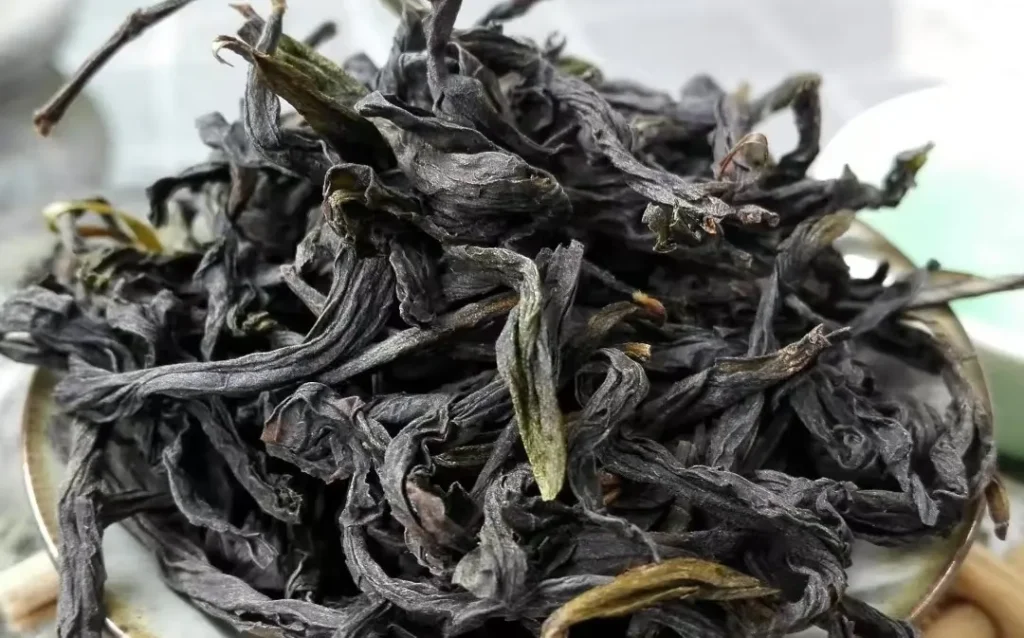Oolong tea, also known as Qing Cha, is primarily produced in Fujian, Guangdong, and Taiwan. It is a semi-fermented tea that falls between black and green tea, with a color resembling iron, hence the name Qing Cha. The leaves have a characteristic ‘green leaves with red edges’. Oolong tea has a legend associated with it. A tea garden owner, upon checking the tea leaves that were about to be sun-dried, was startled to see what appeared to be a black dragon in the garden.
Upon closer inspection, it was the oxidized green leaves that resembled a dragon. Although it was a false alarm, the oxidized tea leaves were found to be rich in aroma and taste, thus named ‘Oolong Tea’. After processes such as sun-drying, frying, and baking, Oolong tea has a dark color and a shape resembling a fish or dragon. When soaked in water, the leaves unfurl with a dark green color, much like a dragon entering water. Oolong tea is rich in caffeine, protein, amino acids, and lipids. Due to differences in origin, variety, and craftsmanship, Oolong tea has various categories and characteristics. One can choose an Oolong tea that suits their preference and savor it to experience the ‘before tasting the nectar, one smells the divine fragrance’.Oolong tea is mild and slightly cool, with antioxidant properties, the ability to break down greasy food, lower blood pressure, and enhance metabolism. The unsaturated fatty acid ‘linoleic acid’ in Oolong tea can reduce blood viscosity, increase blood flow, and regulate blood lipids to lower cholesterol. The main component, tannic acid, is closely related to fat metabolism, capable of dissolving fats and reducing cholesterol levels. The caffeine in Oolong tea stimulates the cerebral cortex, enhancing central nervous system excitement, which can refresh the mind, improve thought, and awaken the spirit. The various vitamins and water-soluble tea polyphenols in Oolong tea can clear facial oiliness, tighten pores, nourish skin cells, alleviate fatigue, and promote gastrointestinal digestion.
The Oolong tea rolling process involves withering, shaking, frying, rolling, and baking, resulting in spherical, strip-like, and twisted shapes. The different degrees of shaking during the process lead to light, medium, and deep fermentation, creating various types of Oolong tea. Shaking enhances the friction of the leaf tips, breaking the edge cells, providing an external force for various changes within the leaf; it accelerates the enzymatic oxidation of tea polyphenols, inducing aroma, and forming the unique high fragrance and mellow quality of Oolong tea; shaking promotes the ‘water movement’ of the tea leaves, changing the way water is released the from leaves, allowing some water to evaporate from the damaged cells; shaking determines fermentation, thus determining different tea characteristics and presenting different aromas, making the shaking process crucial in the production of Oolong tea. Light-fermented Oolong teas such as Wenshan Baozhong and Tieguanyin have green dry tea, green soup color, green leaf base, and an aroma similar to green tea. They have a lasting, refreshing, and tender aroma, with a bright and clear tea soup.Wenshan Baozhong tea has the lightest fermentation level among oolong teas, at approximately 8% to 10%. Its light roasting process makes it closer to green tea, setting it apart within the oolong category. Light-fermented Tieguanyin, a popular fragrant oolong, has a fermentation level of 15% to 20%. The term ‘clear soup and green water’ characterizes the typical features of fragrant Tieguanyin. Medium-fermented oolongs, such as Phoenix Dancong and Wuyi Rock teas, are known for their rich aroma, compact appearance, and tea soups that range from orange-yellow to orange-red, with a fermentation level around 50%. Heavy-fermented oolongs, like Taiwan’s Baihao Oolong and Dongfang Meiren, are fermented to 60% to 80%. Known as the ‘Oriental Beauty,’ these teas display visible white hairs, connected branches and leaves, and an amber-colored tea soup with a fragrance reminiscent of black tea, featuring honey and fruit notes. The production of oolong tea begins with the picking of fresh leaves when the tea plant’s new shoots have grown 3 to 5 leaves, with the top leaf being six or seven. The picking process involves selecting 2 to 4 leaves. Different times, regions, varieties, moisture levels, and tenderness are all considered during the picking process. The influence of picking on oolong tea is significant; leaves picked before 10 a.m. carry dew, while those picked between 4 and 5 p.m. miss the optimal sun exposure for withering. The quality of leaves picked between 10 a.m. and 12 p.m. is superior due to sunlight exposure and dew evaporation. Leaves picked from 12 p.m. to 4 p.m. are fresh and fragrant, with ample time for sun exposure, resulting in excellent tea quality. The weather plays a crucial role in the quality of oolong tea. Continuous sunny days are ideal for producing high-quality oolong tea, as continuous rain prevents the leaves from sun exposure, making it difficult for the ‘green withering’ process and hindering the normal transformation of internal substances, thus preventing the formation of high-quality oolong tea. The withering process of oolong tea is crucial. Proper brewing techniques enhance the quality of oolong tea: 1. Mountain spring begins to boil; 2. White crane bathes; 3. Oolong enters the palace; 4. Kettle pours high; 5. Spring breeze touches the face; 6. Guan Gong inspects the city; 7. Han Xin points to the soldiers; 8. Taste the sweet nectar.


